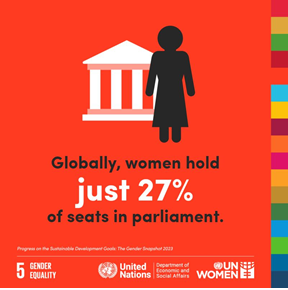TOGETHER, STEP BY STEP
Relevance: GS 1 – Role of women and women’s organization, population and associated issues, poverty and developmental issues, urbanization, their problems and their remedies
Why in the News?
- Former Wrestling Federation of India chief Brij Bhushan Singh’s son secured a BJP ticket for Lok Sabha elections from Kaiserganj, Uttar Pradesh, maintaining the family’s power.
- This exemplifies patriarchal norms that disregard concerns of champion women wrestlers, despite male-dominated establishments endorsing women’s equity.
- Gender equity requires collective action from women, rather than individuals dropping out of the fight.
- Existing male leadership may not be sufficient to drive significant change.
- Female leadership is crucial for providing the necessary counterbalance and pushing for effective measures.
Non-linear Progress of Women’s Equity
- The journey for women’s equity in public discourse is not linear.
- Progress is measured by steps taken, not taken, or even steps taken backward.
- It’s a constant churn in a systemic process aimed at eliminating latent misogyny.
- Global Women’s Movements: Despite repression or regression, women’s movements are gaining momentum.
- 29-year-old Saudi activist Manahel al-Otaibi continues advocating for women’s equity and rejecting male guardianship despite incarceration through the hashtag #societyisready.
- Support for activists like al-Otaibi is growing globally, indicating increasing solidarity.
- Iranian women receive support from marginalized women in Afghanistan, echoing the Kurdish women’s chant of “Women, Freedom, Life!”
- Women in Mexico assist their US counterparts in navigating abortion bans, illustrating cross-border solidarity.
- Harvey Weinstein’s incarceration for sexual assault reflects accountability spurred by the #MeToo movement.
- 29-year-old Saudi activist Manahel al-Otaibi continues advocating for women’s equity and rejecting male guardianship despite incarceration through the hashtag #societyisready.
Perception of Women’s Empowerment
- “Women’s empowerment” often stems from male largesse or guilt-tripping, rather than genuine agency.
- Women are often given what men think they need, reinforcing a sense of powerlessness, especially in traditional cultures where inequity is normalized.
- Strategic Persistence in Leadership: Women must strategically navigate within existing systems to earn leadership on their terms, avoiding premature exits.
- Quitting perpetuates hopelessness and relinquishes stake in leadership, hindering progress towards gender equity.
Workplace Challenges
- Despite redressal mechanisms, workplace sexual harassment forces women survivors to leave jobs due to mental scarring, sidelining, and judgment from colleagues.
- A lack of women in senior management undermines acknowledgment and addressing of harassment as an organizational problem.
- Coercive Nature of Sexual Harassment: Sexual harassment serves as a coercive tool to eliminate women competitors who statistically outperform men, particularly in male-dominated fields.
- Pushback against sexualizing women co-workers reflects reluctance to cede territory and reinforces societal collisions with detrimental consequences for survivors and their ecosystems.
Gender Disparities in Decision-making and Employment:
- UN Women reports low representation of women in decision-making processes globally:
- 27% of parliamentary seats,
- 36% of local government seats, and
- 28% of management positions are held by women.
- Prime working-age women face lower job participation rates compared to men, with only 61% of women employed compared to 91% of men.
Way forward to the Gender Disparties
- Challenging Normative Behavior: The issue extends beyond gender divide; it involves reversing normative behavior, a challenge men have not faced.
- Women are tasked with a tougher climb in this regard, necessitating collective pushback rather than dropping out or passively benefiting from existing norms.
- Need for Systemic Change:
- Redressal mechanisms must treat sexual harassers as social and economic liabilities, shifting from “protecting” women to “punishing” abusive oppressors.
- Female leadership is crucial for effecting this change and providing the necessary counterbalance to existing male leadership.
- Collective Action for Change:
- To address these disparities and challenge normative behavior, women must push back collectively.
- Dropping out or benefiting individually is not enough; collective action is essential for meaningful change.
Source: The Hindu
Associated articles
https://universalinstitutions.com/empower-women-for-lasting-prosperity/
https://universalinstitutions.com/government-of-india-initiatives-for-women-empowerment/
Mains question
Discuss the challenges faced by women in decision-making roles and employment. Evaluate the necessity of collective action in challenging normative behavior. (250 words)





